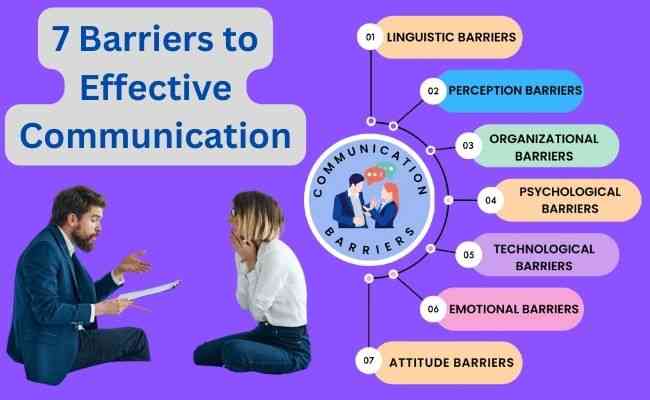


Whether it’s verbal, nonverbal, written, listening, or visual, if we don’t communicate effectively, we endanger both ourselves and those around us. We do not convey our message appropriately.
We face the issues of barriers to effective communication. Miscommunication creates a difference between the sender’s meaning and the receiver’s meaning. We see everyone is different from others mentally, physically, and emotionally.
This difference causes a number of problems. Such problems create miscommunication. People’s personal and professional lives get affected by the miscommunication of messages.
Each person’s mind is a unique filter. Communication problems are more likely to occur when the communicator’s filters seem sharply different. The message, the sender’s meanings, and the receiver’s response get influenced by numerous factors such as:
1. Linguistic Barriers
Conventions of Meaning
2. Perception Barriers
Perceptions of Reality
3. Attitude Barriers
Values, Attitudes, and Opinions
4. Psychological Barriers
Personality clash
Lack of knowledge
Lack of interest
5. Emotional Barriers
Emotionalism
6. Technological Barriers
7. Organizational Barriers
An important rule of communication is that the sender’s symbols to communicate messages must have the same meaning in both the sender’s and receiver’s minds. Otherwise, the process of communication will fail. For example, Bull and Bear, etc. are the market terms used widely in market reports.
Obviously, a market operator is well aware of all such terms. However, for, a common man these are the words used merely for the animals. Thus, when the sender and receiver attribute a different meaning to the same words, miscommunication takes place
In order to avoid such miscommunication, we should be sure that our words convey the same meaning our reader has in his mind. Miscommunication occurs because the words have both denotative and connotative meanings.
The dictionary definition of a word is denotation. Denotations do not indicate negative or positive qualities. Words like pen, chair, college, book, etc. only have denotative meanings. The receiver gets the same idea as what the sender wants to convey.
Some words have some additional or secondary meanings other than their dictionary definitions. These secondary meanings are known as connotations. These meanings arise due to personal feelings or reactions for example the word man is denotative whereas father, prophet, and brother are connotative.
Euphemism is the art of saying direct, serious, and unpleasant things in a pleasant and gentle way. For example, perhaps you have forgotten that is a euphemism for you are a liar. Similarly passing away is a euphemism for dead or died.
The remedy to the above problems is that the sender should use simple words keeping in view the mental and educational level of the receiver.
Every person has his own perceptions of reality. What is a special reality for one person may not be the same for the other. Like the conventions of meaning, perceptions of reality also vary from person to person. We make abstractions and inferences to comprehend reality.
When we receive a message, we usually concentrate on some details and neglect others. This process of looking for relevant information and omitting less important things is called, abstracting.
The process of making conclusions on the basis of assumption and observation is called inferring.
The remedy to this problem is that the receiver should never make abstractions and inferences. He should pay attention to the message patiently.
Our response to a message is often influenced by our attitudes, opinions, and values If a message is according to our hopes, we react to it favorably, whereas we tend to reject disagreeable messages.
Similarly, our opinions relating to any happening, incident, and event affect the meaning of a message. Following are some of the elements based on values, attitudes and opinions which are responsible for miscommunication.
Some people make up their minds on certain facts and refuse to change them. It is never easy to communicate with such people.
In order to get a favorable reaction, the credibility of the sender is very important. An effective sender builds credibility by writing and speaking in a Just manner.
It is a statement that is not exact rather it is dipped into the color of one’s own likes and dislikes. One should never include one’s biased ideas in any particular fact.
The above barriers may be overcome by the policy of honesty and understanding. People should state what is truthful and they should not feel any hesitation in accepting other people’s opinions.
It is very difficult to communicate with a person whose knowledge is less than yours. So lack of knowledge on the part of the receiver causes problems in communication.
This type of barrier can be overcome if the sender keeps in view the educational level of the receiver.
Lack of interest on the part of the receiver is also a barrier to communication.
This type of barrier can be overcome if the speaker creates interest in his speech.
No two persons can be of the same temperament and intelligence. So, this creates a clash of personalities, a barrier to communication.
We cannot change the personalities of others. For this purpose, we find a smooth flow of communication. we should change ourselves and respect others’ points of view.
Emotionalism leads to irrationalism. Our emotions of anger, hatred, liking, and disliking affect the message we convey to others. Nobody listens to our irrational talk. Therefore, emotionalism is another barrier to communication.
The remedy to this problem is that communication should be suspended when the communicator or the receiver is at the height of emotions.
It’s important to stay up-to-date with the ever-changing technologies. Yet not all workers are technologically competent. Moreover, technological innovation frequently raises operating expenses for businesses.
All of these result in communication hurdles in the workplace due to technology. Additionally, there are socio-religious barriers like a preference for women, lower caste individuals, and transgender communities.
The remedy for this barrier is to motivate the employees to be aware of the latest technological advancements. They should learn about new technologies.
An enterprise has various organizational designs that create a hindrance in the process of communication. A variety of settings and arrangements might lead to misinformation, poor communication, or lack of openness.
If there are multiple structures in any organization, the workers should be limited to their field or setup. They can learn about other structures by adopting features of other setups.
Every day, we interact with individuals in many ways. Conversation, our facial expressions and body language, social media, email, the phone, etc. are all ways that we communicate. We rely on our communication abilities to strengthen our bonds with friends, arrange trips, mend broken marriages, place dinner orders, buy cars, voice our thoughts, solicit assistance, close deals, accept job offers, etc.
We ought to be experts when we communicate in so many different ways constantly. There are barriers to effective communication that we should remove to gain success in the communication path.
The people in the world are different from each other mentally, physically and emotionally. This difference causes a number of problems. Similarly, each person’s mind is a unique filter. A fundamental principle of communication is that the symbols, the sender uses to communicate messages must have the same meaning in both the sender’s and receiver’s minds Denotations, Connotations, and Euphemisms.
Every person has his own perception of reality. What is a special reality for one person may not be the same for another Abstracting, Inferring, Values, Attitudes, and Opinions? Some people make up their minds on certain facts and refuse to change them. It is never easy to communicate with such people.
One thought on “7 Barriers to Effective Communication You Must Know”